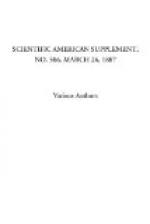Gaseous fuel is more manageable in every way than solid fuel, and is far more easily and reliably conveyed from place to place. Dr. Siemens, you remember, expected that coal would not even be raised, but turned into gas in the pits, to rise by its own buoyancy to be burnt on the surface wherever wanted. And not only will the useful products be first removed and saved, its sulphur will be removed too; not because it is valuable, but because its product of combustion is a poisonous nuisance. Depend upon it, the cities of the future will not allow people to turn sulphurous acid wholesale into the air, there to oxidize and become oil of vitriol. Even if it entails a slight strain upon the purse they will, I hope, be wise enough to prefer it to the more serious strain upon their lungs. We forbid sulphur as much as possible in our lighting gas, because we find it is deleterious in our rooms. But what is London but one huge room packed with over four millions of inhabitants? The air of a city is limited, fearfully limited, and we allow all this horrible stuff to be belched out of hundreds of thousands of chimneys all day long.
Get up and see London at four or five in the morning, and compare it with four or five in the afternoon; the contrast is painful. A city might be delightful, but you make it loathsome; not only by smoke, indeed, but still greatly by smoke. When no one is about, then the air is almost pure; have it well fouled before you rise to enjoy it. Where no one lives, the breeze of heaven still blows; where human life is thickest, there it is not fit to live. Is it not an anomaly, is it not farcical? What term is strong enough to stigmatize such suicidal folly? But we will not be in earnest, and our rulers will talk, and our lives will go on and go out, and next century will be soon upon us, and here is a reform gigantic, ready to our hands, easy to accomplish, really easy to accomplish if the right heads and vigorous means were devoted to it. Surely something will be done.
The following references may be found useful in seeking for more detailed information: Report of the Smoke Abatement Committee for 1882, by Chandler Roberts and D.K. Clark. “How to Use Gas,” by F.T. Bond; Sanitary Association, Gloucester. “Recovery of Volatile Constituents of Coal,” by T.B. Lightfoot; Journal Society of Arts, May, 1883. “Manufacture of Gas from Oil,” by H.E. Armstrong; Journal Society of Chemical Industry, September, 1884. “Coking Coal,” by H.E. Armstrong; Iron and Steel Institute, 1885. “Modified Siemens Producer,” by John Head; Iron and Steel Institute, 1885. “Utilization of Dust Fuel,” by W.G. McMillan; Journal Society of Arts, April. 1886. “Gas Producers,” by Rowan; Proc. Inst. C.E., January, 1886. “Regenerative Furnaces with Radiation,” and “On Producers,” by F. Siemens; Journal Soc. Chem. Industry, July, 1885, and November, 1885. “Fireplace Construction,” by Pridgin Teale; the Builder, February, 1886. “On Dissociation Temperatures,” by Frederick Siemens; Royal Institution, May 7, 1886.




